This is what I've been up to for the last 8 months - a guide to global warming and its impacts on New Zealand. Hot Topic will be published by AUT Media in August. Details at the Hot Topic web site - which includes a supporting blog. If you're interested in climate change and what it means for NZ, I hope you'll pick up a copy of the book - and the blog will keep you up-to-date with climate news. Now I have to get back to the final editing...
Music & Books
A week ago, I had an idea for a book. I wanted to turn dissembling into profit, or at least not such a waste of time. I sent an email to an expert in the field. He rang me back half an hour later to say that he thought it was a great idea. I rang my favourite NZ literary heavyweight, who also thought it was worth doing. A couple of days later, he told me a publisher had given the project the thumbs up. So I'm hard at work on a sample chapter, which should lead (with luck) to a contract, and then 45,000 words will have to be delivered by Christmas, for publication in the (NZ) autumn. More information about subject matter when a contract's signed - but it's something I consider very important. Time to extract several digits.
Time for a bit of book marketing. A little while ago, I submitted The Truffle Book to Google's Book Search feature. The full text of the book is searchable (here), and you can read relevant pages (scanned in from the pdf edition). Although the whole book is available, you can only read about 20% at any one time - which seems like a sensible limit to me. After all, the pdf edition isn't exactly expensive - NZ$15 is about US$9.40 or £5.10 - and I would like to make a profit on the exercise.
Meanwhile, my US and UK distributors have put the book on Amazon.com and Amazon.co.uk. If you've read the book and enjoyed it, how about contributing a reader review? Or putting it on your wish list? You might suggest a friend buys a copy there, just to push the sales rank up a bit.
UK readers can also purchase the book from Truffle UK (who recently sold quite a few copies at the Chelsea Flower Show, and have a nice congrats message on their homepage). I suspect they also had a substantial hand in getting the book plugged by gardening writer Bunny Guinness in The Sunday Telegraph back in June (not available at the Telegraph website (yet?):
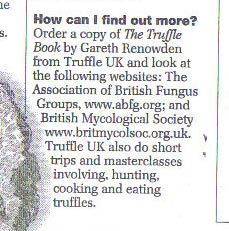
Not exactly a review, but a firm recommendation... and sorry about the pic alignments going wonky*. I'm struggling with the Flint css... Mark?
Good reviews are always welcome, especially when they're by someone who knows whereof they write. So thanks, Barbara at winosandfoodies.com for taking the time to read the book and post so nicely about it. She ploughed through the PDF edition in about a day, which shows great determination!
Don't open the tin, Barbara...
Here's the link for the Radio New Zealand archive of Saturday's Kim Hill show. It seemed to go well. If you wonder why there's a brief diversion into Welsh vocabulary in the middle, it's because one of her earlier guests (physicist Paul Callaghan) was discussing colour, and opined that the Welsh had no word for green. He was wrong. The stream will be available for four weeks (Windows Media Player required).
I'm being interviewed by Kim Hill - New Zealand's finest radio host - on her Saturday morning show on National Radio this week. Unless the schedule changes at the last minute, I'm due on at about 11-20am, after the regular food spot. You can listen to a live stream from the RNZ site (go to one of the links above and click on the Audio box in the top left of the page header), and the interview should be hosted on the RNZ site for four weeks afterwards. I'll post a link when I have one.
Limestone Hills Publishing is pleased to announce the new limited edition hardback version of The Truffle Book, and for those who like to read on-screen, the brand new PDF edition. The hardback edition is strictly limited to 150 copies, reasonably priced at NZ$69.95, each hand-numbered and signed by the author. The PDF edition is priced at $NZ15 (roughly US$10, GB£5.70, E8.20) and I'll sell as many as people want, but PDF purchasers who want the full book experience (more bandwidth, fully portable, no batteries required) will be able to buy either paper-based edition with a NZ$10 discount.
I'm now toying with ideas for the audiobook version. I need a cheap studio in Christchurch to record the basic audio tracks, and then I can do all the editing in Garageband. Anyone fancy a truffle podcast?
After much huffing and puffing, the new Limestone Hills web site is live, and quite probably kicking. It's built with Freeway Pro, and uses some "actions" (a kind of plug-in that add functionality in the Freeway universe) to hook up to Mal's e-commerce (free, and highly recommended by Freeway people). It looks as I think it should when viewed with Safari (the Mac OS browser), but is now reasonable in most browsers on most platforms that I've tried (which is not all that many).
So what's new? Well, I think it looks a lot better - new header, new layout and organisation, and buttons to press and videos to view. And I can now accept credit card purchases of the book. Will anyone buy it? I need a few sales a month just to cover the bank charges...
Two more reviews: one formal, one informal and unattributable. The first, from the Rotorua Daily Post/Weekender, by Judith Moore:
His book is a revelation — everything you want to know about truffles — the international scene, how to fondle and sniff a truffle, recipes, history, dog training. Most important of all, he gives instructions on how to grow your own truffle. With deft touch, entertaining text and good photographs, Renowden skips over the difficulties — alkaline soil, 10-year wait, porcine poachers — and waxes lyrical over the end results.
The informal review is a little more effusive. In it, a senior member of the British royal family (his name begins with C and he lives in Gloucestershire) thanks a friend for his Christmas present:
Bless you for sending me that absolutely rivetting book on truffles! It is un-put-downable!
In a further sign of royal approbation, the writer's father has ordered extra copies for the Palace library. Unfortunately, royal etiquette means I can't use the quote on the cover, but I am chuffed. As is my mum.
The Truffle Book was always intended to have an international audience. It's about the world of truffles and the truffles of the world, so I was particularly please when Jon Bonné, lifestyle editor on MSNBC, referenced the book as a source in a piece about aphrodisiacs, cunningly timed for Valentine's Day. Jon's blog, Amuse-bouche is also well worth a visit - full of interesting bits and pieces, or as he calls them, lagniappes...
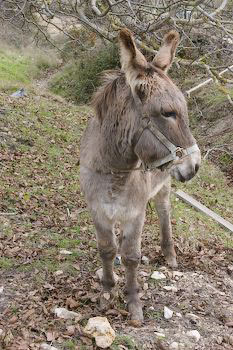
The proverbial ass (a truffle ass, near Ollogoyen in Spain)
Never believe a writer who says he never reads his reviews. We all do. If they're good, it's vanity - if they're bad, it's a pain in the proverbial ass.
Shortly before I headed off to Europe I bagged up a stack of copies of The Truffle Book and sent them off to the book reviewers of New Zealand. Now the reviews are beginning to trickle in. The Nelson Mail did a very nice write-up (see below), and I've just had a clipping of Charmian Smith's review in the Otago Daily Times. She describes it as "very readable" and "an excellent introduction to the fungus for those who are thinking of growing them, and those who just like to know about highly prized ingredients". Thanks, Charmian. I wonder when the first bad review will arrive?
Here's the big news: I have copies of The Truffle Book. Four pallets each laden with 40 brown boxes stuffed with lovely little books, the fruits of a very long labour. Copies will go out to everyone who helped me in the next day or so, and review copies shortly thereafter. The NZ distributor (Nationwide) starts the sell-in next week. Copies should be in NZ bookstores soon after. The big promotion push won't happen until late summer (Feb/March) because we're getting too close to Christmas (and it pains me to say that - it's still months away), and I'm still waiting to hear from Australia, but I'll have copies for sale on the Limestone Hills site very soon. In the meantime, don't forget you can download a pdf sample here. Time for a drink... Muddy Water 2001 Syrah when I get home.
The new Limestone Hills web site has just been uploaded, and a sample pdf of the Foreword, Introduction and first chapter is now available for download.. Just go here, and click on the download link. I'm currently finalising proofs with the printer and resolving a pre-press issue (the strange case of the disappearing ligatures) (not a medical problem). The whole thing should be on press very soon. I have to put my selling boots on. I wonder if they'll fit.
Preflighted (who'd have guessed that there were some odd little bits of Times lurking in pages of Hoefler Text), packaged, and burned to DVD (twice). Then over to the printer to drop it off, look at a paper dummy, discuss timings. Should be on machine in the last week of the month, and delivered by the end of the second week of October. Now I have to turn into a sales and promotion person. First priority: an A4 promotional sheet I can send to people, and then I begin the sell-in. It looks as though I'll have about a month to get the thing "launched", because in the second half of November I'm off to Europe for a month. A week in London, a mushroom conference in Spain, and then a tour of the truffle business in Spain followed by a few days in the Périgord. So I'll have four weeks to "do" the initial NZ promotion of the book - four weeks to get the book being noticed, and bought. Will I be left with four pallets loaded with unsold books?
I also have to do some sustained work on the Limestone Hills website, particularly the book pages. I'm aiming to have a .pdf sample of the book available for download in the next few weeks, and the full book available for download soon after the print launch.
The Truffle Book has steadily been taking shape over the last few weeks. I've got one more chapter to lay out, but the rest is ready for proofreading and the cover is in the final stages of tweaking. Off to a printer in a couple of weeks. Out in October?
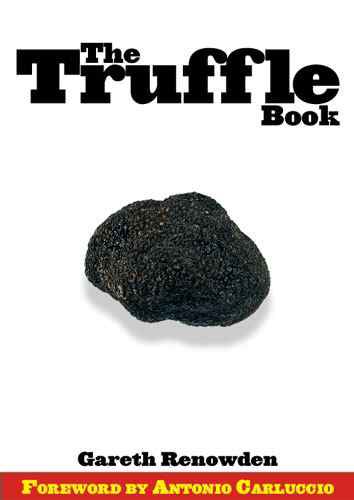
With luck, it will attract attention on bookshop shelves, if only because the truffle on the cover could, according to a friend of mine, be mistaken by the uninitiated as a turd. I think it looks rather m ore like a warty UFO, but if it is in any way turd-like, then I will claim that this was a deliberate design ploy on my part, designed to set up a cognitive dissonance in the viewer, thus drawing them in to check out the book.
The truffle itself weighed 30g, was harvested at John & Iris Burn's Ashburton truffière in July, and provided by them for photography free of charge. Sadly, from an eating point of view, it had been frozen. Thanks very much indeed, John and Iris. You'll be getting a credit in the book, of course.
Over the years, Antonio Carluccio has had a large part to play in the development of our family cuisine. When Camille I were first married, and it became apparent that if I wanted to eat something other than takeaways I'd have to do the cooking, the first cookbook we bought was Antonio's An Introduction To Italian Cooking. It fired me with an enthusiasm for Italian food and by some strange osmosis his evident love for finding and eating wild mushrooms worked its way into my system.
A couple of years ago, Antonio was the star guest at a local foodie masterclass weekend (Savour New Zealand), and visited Limestone Hills. He cooked porcini in our kitchen:
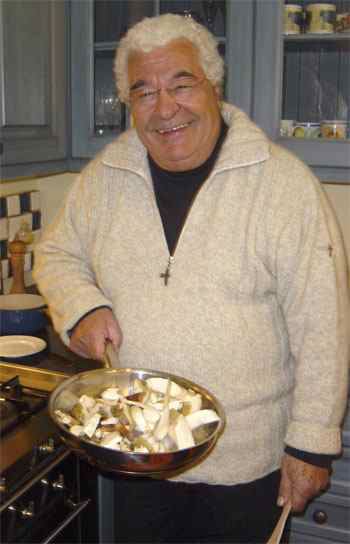
I had a chance to blame him for my current lifestyle - and get him to sign that tattered old cookbook. He took it all with good grace, and had a good time - one abiding memory is Antonio and pinot guru Danny Schuster sitting in the sun telling each other an endless stream of filthy jokes.
A few weeks ago I rather cheekily emailed Antonio and asked if he'd be willing to contribute a foreword for The Truffle Book - and he said yes. I have the text sitting in my computer ready to go. His only stipulation? That I send him my first truffle.
With pleasure Antonio. It's all yours. And if I could hand deliver it and enjoy a meal at Neal Street, I'd love to… All I have to do is find it.
A short note. An apology for a prolonged absence from the web. I've been stuffing transparencies into my new Nikon slide scanner and waiting 15 minutes while the computer transforms them into something I can use in the book. I still need to write about Collapse, by Jared Diamond, the visit to the farm by France-based US food writer and teacher Patricia Wells, the beginnings of the truffle season, and other things. I may manage some soon. With luck.
The Cook Islands were wet. We had rain on most days, but only one whole day and a couple of afternoons were completely washed out. We sunbathed during the bright bits and snorkelled in the rain. The latter (the swimming, not the rain), at the tiny atoll of Aitutaki, was outstanding - giant clams, big fish, clear water. There was music too - a fabulous little acoustic band called The Sunrays.
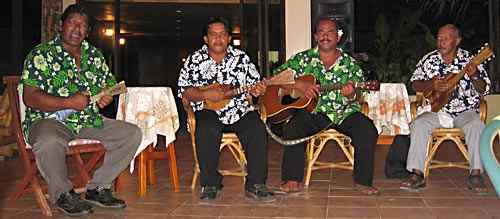
The Sunrays in full flow...
They were playing to accompany our dinner at the resort, and ran through what I took to be loads of Cook Islands favourites. Lovely soft acoustic ukulele and guitar, no drums, and sweet, very laid back singing. The big guy on the left plays a uke about as big as his forearm, while the old guy on the right immediately reminded me of those Cuban maestros from the Buena Vista Social Club.
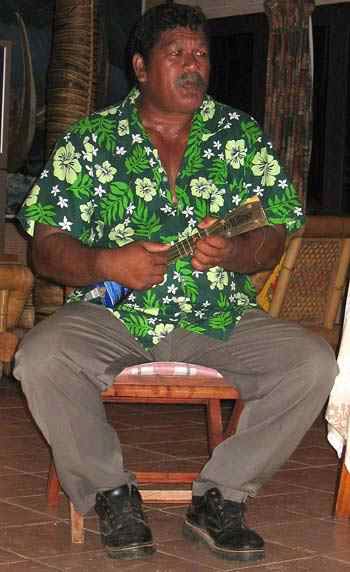
The big guy on the left...
We'd had bands playing through dinner at our Rarotongan hotel - much the same sort of repertoire, but with amplified ukes and drum machines spewing out cod Pacific/Latin rhythms. With a limited repertoire of arrangements, and restricted dynamic range, those bands swiftly became a mildly diverting background noise - and by the end of the evening something of an irritant.
The Sunrays are in a different league. Their obvious love of singing, and the infectious nature of their playing compensated for any sameness in the arrangements. The only songs I recognised were My Bonny (rather more laid back than Tony Sheridan and The Silver Beatles' version) and a beautiful Teddy Bear, without any Elvis overtones. Some might say that the wine, after a rather wonderful day peering into giant clams, was affecting my judgement, but I prefer to believe that The Sunrays are one of the Pacific's great undiscovered secrets. I commend them and their island to you all.
Fourteen chapters of The Truffle Book were emailed to my editor, the very excellent NZ literary heavyweight Mike Bradstock, this afternoon. He will no doubt dissect it and tell me that large chunks are tripe and need to be re-written, and I will meekly do as he says. Well, perhaps not meekly.
For a few weeks I shall cease to be a writer. My magical transformation into designer, scanner operator and production manager is about to begin - but a little later than I had envisaged. My scanner of choice, the Nikon LS 5000, is out of stock in NZ, and I won't get one until the end of April. Irritating, but unavoidable, and not disastrous, given that two weeks in April are being given up to holidays: the Cook Islands. In the meantime there's the NZ Truffle Association conference to get organised, and a book to design.
A deep sigh of relief has been heaved. Now what shall I write next?
The word count for The Truffle Book has been ratcheting up steadily over the last five weeks, and I'm well within sight of my 40,000 word target. Today, however, I took a step backwards. I cut a huge chunk out of one chapter because I'm in severe danger of overshooting that target. I cut 2,500 words, but then wrote 1,000 so the net loss wasn't too dramatic. It was mainly undigested notes pasted in, so not a great loss.
My style is hardly terse, in fact it's rather discursive (but not flowery, heaven forbid), so my editor will be able to trim some fat, but if I go too far over the top the page count of the book will go up, costs will rise, and that'll either put pressure on my margins or the finished price of the paper book. Not a problem for the pdf version, except perhaps for bandwidth issues. Quality words only from here on in.
I'm two weeks over my original schedule for finishing the text, so hitting my early May target for publication is now unlikely, but I don't care (much). It's such a relief to be making significant progress, and I have a feeling that some of the stuff is not too bad. Makes me smile, anyway.
I'm beginning to think about pictures and illustrations. I'm planning to buy a 35mm slide scanner to handle all my slides (there are quite a few from all over Europe and NZ, and buying a scanner is near enough the same price as having the scans done professionally), but I still need to source others. Another bridge to cross (in due course).
The wordcount of The Truffle Book (see column on the right) has just ratcheted up a few hundred words. I'm a little over a third of the way to my target word-count of 40,000 carefully chosen and finely honed words. Words that can then go to a suitable editor for a second opinion.
I have a target in mind. I've been involved in a small way with Savour New Zealand, a gourmet masterclass weekend held every two years in Christchurch. I've been a panellist and hosted some of the celebrity presenters up at Limestone Hills (including Antonio Carluccio). This year, Anthony Bourdain of Kitchen Confidential fame is lined up as the headline guest. If I can get the bloody thing written and published by the second weekend in May, perhaps I can launch it there. Even if I can't do anything official, perhaps I can stuff fliers into people's hands, sign copies, go down on bended knees and plead for sales, all the usual marketing things.
So I have a goal, and that forces me to commit to a schedule. Finish the text by the end of February, design and edit the book during March, and print it during April. The printing part is the only real difficulty - it forces me to use a local printer, which may not be as cost effective as using a Singaporean or other SE Asian press, but that may be no bad thing. I support my local winemakers, so I should be prepared to support my local printer.
The Truffle Book (or whatever it will be called): due in May 2005 from Limestone Hills Ltd. Downloads of the first couple of sections free of charge, the full book for about US$10. Printed copies available on bookstalls in NZ, by mail order around the rest of the world. Bookstall publication rights available in all other territories. Translation rights available.
Form an orderly queue, please.
And if I haven't finished writing it by the time my wife gets home from her current overseas trip, I face unspecified sanctions. So I'm working for a quiet life. I hope.
Brian Wilson played Christchurch. I was there, and it was one of the best concerts I’ve ever been to (and I’ve been to a few). An amazing night, one that several of the good burghers of Christchurch assure me will pass into the local collective memory (along with a 70s Santana concert, apparently).
The James Hay theatre in the town hall complex is a smallish venue and must have been quite a change from the Sydney Opera House, but I’m in the third row, slightly to the left of Brian. It is - or feels - intimate, or as intimate as these things get, helped perhaps by the number of people in the audience who know each other. My rock writer mate’s in his element, pointing out David Kilgour (The Clean), introducing me to Martin Phillips (The Chills). The guy who sold me the marble benchtop for the farm kitchen says hello, and Christchurch’s tame Rutles fanatic is immediately indentifiable, front row centre, by his bald patch. (He hadn’t worked out the Beach Boys link, though).
The band are spectacularly good. In the opening acoustic songs, the singing is exquisite, and when they get into the rockier stuff, they really give it some wellie. One guy switches seamlessy between guitar, French horn, trumpet, keyboard and theremin (no, not a leg, sadly). Another looks like a young Dr John. Brian sits behind a Yamaha keyboard reading his lyric and cues off a couple of screens. The keyboard is touched precisely once. If you want a set list, there’s one in this rather emotional account of the Brisbane concert from a couple of nights earlier.
He seems to be running off a script: as if he finds security in the exact sequence of actions and running order. A couple of times he ends songs with an amazing bright smile on his face, only for it to switch off instantly as the band finish. He starts his intros before the audience have stopped clapping and cheering - as if he’s slightly disconnected from events. But whatever his mental state, however he gets through the night, he is most certainly there in the music. And his band obviously love him.
Sometimes the BBs canon sounds thin and weedy to my ears. Great songs, but not a lot of balls. Not tonight. Everything goes better with this band and the volume helps a lot. SMiLe, in particular, gels as a live performance in a way that it doesn't on CD. Played loud, it makes sense.
Marcella closes the first half. What a song! I’ve been playing the BBs version every day since, but the live version is much punchier.
In the final rock'n'roll section, (Do It Again, Fun, Fun, Fun etc) a theatre full of mostly middle-aged bodies begins to heave. There's dancing in the aisles. A security guard stands up on the side, nervous at first, then smiles and shimmies a bit. Brian has his bass guitar strapped on, but his fingers don’t seem to do more than they did on the keyboard.
On the way home, I set the iPod to shuffle though a playlist of 400 psychedelic classics from the late 60s (OK: they’re not all stone cold classics, but they’re much more than interesting), and it’s immediately apparent that the new SMiLe is a part of that milieu. Brian must have been as acid-fried as Syd Barrett when he conceived the piece, and it must have cost him some effort to get back there to finish the thing off. If, indeed, he did. I have a sneaking suspicion that chief Wondermint Darian Sahanaja did more than just “assist with the arrangements”, and this article gives some credence to that assertion
But what does it matter? One of the rock‘n’roll greats is alive and well(ish), touring, and delivering performances that reduce grown men to tears. Not me, though. I was reduced to dancing like a madman trying to be cool, and singing, trying to prove that I knew all the lyrics. Good job I didn't have a mike.
Brian’s antipodean tour reaches the parts other bands often don’t.
I was all set to start saving up for a trip to see Brian Wilson performing SMiLe at the Sydney Opera House in December, when - by something not far short of a miracle - I learned he was going to turn up in Christchurch on December 17th in the Town Hall. Fabulous. You may expect a review in due course.
Somebody's beaten me to The Truffle Book!
I'm sorry if you're offended by the word “bugger”. It’s an everyday part of the language down here, thanks in no small part to an amusing TV ad for a farm vehicle. It is also a precise expression of my frustration at discovering that someone else has beaten me to the use of The Truffle Book as a title. Now I'll have to think of something else, and the carefully cultivated uniformity of my book titles has been destroyed.
Perhaps I’ll call it something pretentious like Truffle: From Tree To Table, or just Truffles. Anybody got any ideas?
On Tuesday I called in to Radar Records in Christchurch. I left with the new Elvis Costello CD and the remarkable new Nick Cave double, but I didn't get my paws on Smile. Yesterday, as I passed the record store in our local mall I heard a faintly familiar fragment, and diverted rapidly inside. Smile was looking up at me from the “now playing” pile, so it was immediately purchased. It has been on various players ever since. In fact I’m ripping it to the iPod as I write.
The story of the great lost Beach Boys album is probably familiar enough to anyone who’s bothering to read this entry, so I'm not going to rehash that. Rather, I’d like to ruminate on my personal relationship with this music. It goes back a long way, and as the years have gone by seems to have got deeper and broader. Sloop John B was the first BB’s single I bought. Spring 1966. My Dansette could only play singles. That summer I really, really wanted to buy God Only Knows - the song struck the 12 year-old me as incredibly beautiful, it was evocative of things that I was too young to know about - but my mother was convinced I was spending too much money on records, and banned it. And Eleanor Rigby. By the time Good Vibrations came out (when fall breaks and turns to winter (October?) - odd timing for a record that’s so bloody summery) the ban was lifted. I couldn't buy Pet Sounds (or Revolver) because of my Dansette limitations, but by the time Sgt Pepper was out, I had something that could cope. Pepper was the third LP I bought. I very nearly bought Smiley Smile, the follow-up to Pet Sounds, but as I already had the two singles on it (I remember being faintly disappointed with Heroes & Villains when I brought it home from the shop - it was from the same mould as Good Vibrations, but not quite so immense) I didn’t bother. I did buy Wild Honey though, and remember feeling vaguely let down. I mean Vibrations and Villains were complex new sounds, pushing the boundaries, like The Fabs were doing, and suddenly the BB’s were doing Motown, going back to basics. It was OK, but what had happened? The mystery deepened with Friends. A lovely little album - but little is the operative word. It was very poor value for money. The whole thing runs for about 25 minutes, at a time when the Beatles were putting 90 minutes on two LPs - even if a chunk of that was Revolution #9. It was a testimony to the quality of the music that I kept coming back for more. The BB’s offering for 1969 was 20/20, and there was a track on there that made my jaw drop. Cabinessence had everything I’d heard in those 1966 singles, and more. I played it to death.
The story of Smile was around in the music press - the inkies, as NME and Melody Maker were known - but it hadn’t meant much to me until I began to realise just what we’d lost. I began to hope that Brian would get his head together and finish the damn thing.
I can’t remember why I didn’t buy Sunflower - probably something to do with money - but I did buy Surf's Up and the title track just made matters worse. It is one of the great popular songs of the last 100 years - not in the sense of being superbly catchy or chart fodder, but as a thing of beauty. The words have just enough relationship with meaning to be evocative (of what, you may ask - columnated ruins dominoing, obviously), and the performance is perfect. I used to turn the lights out and the volume up, and luxuriate. Every subsequent Beach Boys release suffered by comparison with the wonders of that track. I bought Holland and 15 Big Ones and then moved on to the likes of Mr Costello and The Clash. The Beach Boys turned themselves into an oldies band, America’s band or whatever, and became irrelevant. Meanwhile, in a sort of BB’s underworld, bits and bobs of Smile fragments were emerging as bootlegs. Three CDs worth, in all, but I didn’t notice, not being noted as a bootleg purchaser. Too mainstream and not obsessive enough.
We skip to the 1990s. In 1993, Capitol released a boxed set: Good Vibrations - 25 Years of the Beach Boys, a useful summation of the band’s career, but what made everybody take notice was the official release of some Smile stuff. The second CD finished with tracks from the original Smile sessions: an alternate take of Heroes & Villains, the original versions of Wonderful, Wind Chimes and Vegetables - they'd been re-recorded in stripped down versions for Smiley Smile - two obviously unfinished tracks, Do You Like Worms and I Love To Say Da Da, plus snippets of stuff that sounded like they belonged in H&V. Cabinessence was there, and Surf's Up. A stunning, if disjointed selection. The Smile versions of Smiley Smile tracks were much more polished, much more fully realised. These weren’t slight little throwaway songs, they were genius at work. Books have been written about how this stuff was going to be put together to create the final masterpiece. People have played around creating their own versions of the album from Brian's snippets and out-takes, but the only man who really knew how it was meant to work was BW, and he was struggling to get through life without having to go back and revisit music that had driven him to the edge of a drug-fuelled breakdown.
When I’d finally found the £50 to buy the Good Vibrations set, I found myself developing a modest little Smile obsession. Over the last ten years I’ve obtained the bootleg stuff, downloaded some fan assemblages, and passed more than a moment or two wondering which bit went where. If I’d been keeping count, iTunes style, those tracks would certainly be in my decade’s Top 20 most played list.
So with Brian’s return to touring, with his recreation of Pet Sounds, and the news that he was going to have a go at Smile, my interest was rather more than piqued. If I could have found a reasonable excuse to justify the airfare, I would have been in the Festival Hall in London last February when he premiered his new version. In the intervening months I have resisted the temptation to download a boot of the concert, holding out for the official version. I wanted to come to it fresh.
I’ll make the obvious points first. BW’s voice is not what it was, hardly surprising given that he’s 63, but beyond a few awkward moments, you barely notice that. His band, based around the very wonderful Wondermints, more than covers. They’re not the Beach Boys, the voices don’t have that unique blend, but they’re pretty damn fine singers in their own right. The sound is pretty “live” - they’ve recreated not just the sound but the feel of those fragments that we know so well. BW has not rewritten or rearranged the old stuff, just done some deft jigsaw puzzle fitting together, and added some tunes (and Van Dyke Parks words) to the obviously incomplete Worms (now called Roll Plymouth Rock) and Da Da (In Blue Hawaii) - though bits of both themes pop up in several places. For me, the “new” bits work better than the facsimiles of the originals, if only because they can’t suffer in any comparison. The “new” Wind Chimes, for example, is markedly less magical and more mechanical than the first version. Then there’s the question of the sequence. People have been speculating about that ever since Capitol printed some hopeful covers for the original. This Smile is a CD-era Smile. It would not work on an LP. The middle “children’s song” section would be broken in half, and Surf’s Up would start side two. I’d always assumed it would be the album closer, but Good Vibrations does that job here.
Is this the Smile we might have seen in 1967? Obviously not. Too much water under too many bridges for that. This is the work of an older, wiser, survivor, revisiting his youth, not a young man trying to realise his genius (when stoned out of his box). Being older and wiser myself, though not stoned, I love it. Does it work if you come to the whole thing without nearly 40 years of Beach Boys admiration behind you? God only knows.
The Truffle Book is a work in progress. Very slow progress. I'm writing this entry as a warm-up to writing about the chemical constituents of truffle aroma, about half way through chapter three. If I make any serious inroads on that chapter, then the word count in the column on the right will ratchet up a little more. This blog is a way of publicly committing myself to getting the thing written and published, and as long as blogging doesn't replace real work, we'll be OK. I hope.
In 1999 I wrote The Olive Book, intended as a guide to growing olives in the southern hemisphere. It was the book I'd wanted to read when establishing the olive grove at Limestone Hills, and because olive growing has become fashionable in Australia and New Zealand, it's sold reasonably well. We're not talking big numbers here, because there aren't that many olive growers around, but I still get an occasional royalty cheque.
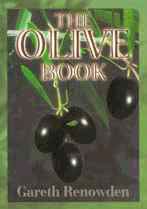
The Truffle Book was intended to be the follow-up, but rather than write a guide for growers (Dr Ian Hall has that market sewn up), I wanted to write an entertaining and informative work for general readers - something along the lines that worked so well for Mark Kurlansky with Cod and Salt. There are quite a few books about truffles in French and Italian, but beyond a few recipe books (mostly translations) and Ian Hall's seminal The Black Truffle, there's nothing much available in English. If you're interested in truffles, my book will tell you more than you ever thought you wanted to know, from the fact that Australia's rare long-footed potoroo gets 80% of its food from indigenous truffle-like fungi, to how to train a dog. (Peg is watching me write this - she's obviously bored rigid).
I started work on the project in 2000, and toured France and Italy that autumn doing research. I also started talking to a London publisher about the book, and through her ended up doing some work on a project for a US publisher. Nothing came of that, although a book bearing a suspicious resemblance to my initial proposal did appear some time later. I made a few more attempts to find an international publisher, but by the end of 2001 I decided that I'd just have to write the damned thing and let the publishing look after itself. So why the three year delay? Difficult to say, really. Probably the biggest single reason is that without the pressure of a publishing deadline, and a publisher breathing down my neck, other things tend to take priority. Things like farm work, articles and photography for Growing Today, and Truffle Association business each seem more pressing. And if you've read the first entry in this blog, you'll see that I like to have big chunks of time to write effectively, and they don't come together all that often.
When the words are finished, I'll do the design and layout myself, and then the book will published by Limestone Hills Ltd in both electronic (pdf) and paper form. You'll be able to download the first couple of chapters free of charge from the Limestone Hills website, and buy the whole thing for about 10 Euros/US dollars. If you then want to buy a paper copy by mail-order, you'll get a full credit for your download purchase. The paper version of the book will also be available in selected bookshops in New Zealand, and perhaps Australia. If publishers in the US and Britain are interested, they can license bookstall editions, and full translation rights will be available for other territories.
This blog is, in a way, part of the promotional campaign. You not only get to read the book (eventually), but you get all the fun of following its creation. Which is what I ought to be doing now.
.jpg)


